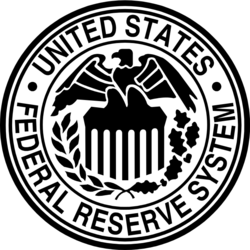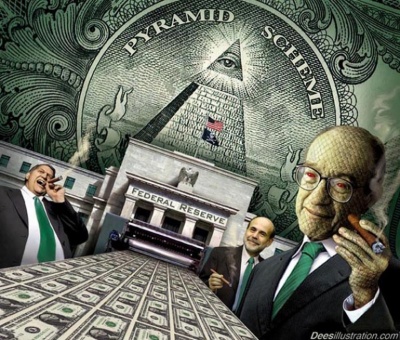US/Federal Reserve
(Central bank) | |
|---|---|
 | |
| Formation | December 23, 1913 |
| Founder | The Money Trust |
| Headquarters | Eccles Building, Washington DC, U.S. |
| Leader | Chairman of the Federal Reserve |
| Subgroups | Federal Open Market Committee |
| Interests | Petrodollar |
| Interest of | Charles August Lindbergh |
| Subpage | •US/Federal Reserve/Chair •US/Federal Reserve/New York •US/Federal Reserve/Vice Chair |
| The privately held cartel which profits from the US$ monopoly. It was set up by The Money Trust on December 23, 1913 after the failure of earlier privatisations by stealth of the US money supply. The petrodollar allowed this system to reap profits globally during much of the 20th century. | |
The Federal Reserve System (FED) is a monopoly which has controlled the US money supply for over a century, set up after the 1913 Federal Reserve Act. It is still believed by many US citizens to be a part of the US government, but it is a privately owned, for-profit company.
Contents
Official narrative
The public at large is encouraged to overlook the fact that this is a private business that was set up by Wall St. bankers, and much is made of the token (irrelevant) public elements.
| A video by James Corbett |
Origins
The Money Trust was an alliance of Wall St financiers. It fought for the control of the US money supply in the 19th and early 20th century, until successfully getting the 1913 Federal Reserve Act past the US government, which created the Federal Reserve, delivering immense profits both from the seigniorage of issuing the US dollar and from the ability to create booms and busts in the US.
Profits
Charging interest on all the United States dollars in existence is a pretty lucrative affair... not least because the petrodollar policy effectively made the US dollar the world's reserve currency.
Concepts and Misconceptions
- True: fiat money is brought into existence by imposing debt on people.
- True: government debt is the primary security accepted by the Federal Reserve System to create "high powered money", which in turn is the basis of other forms of debt.
- True: the amount of government debt is not limited per se, given that tax payments of future generations act as collateral for the government.
- False: interest is a design error of the current monetary system. Interest is a way to ensure scarcity (and profit for those who run the system). Without such a limiting factor the system would not work, because fiat money would have no "value".
- False: money based on debt can be easily replaced by money based on real assets (including government tax certificates). Money based on real assets would radically change the income and power structure of the present society (prosperity of the few). The ability to inflate debt money was and is used to overpower the limited amount of money that can be created based on real assets.
- True: seeking profit equals seeking debt for others. Indebted people and nations may loose part of their autonomy if they fail to bring in the interest.
- True: the fact that the Federal Reserve System is a zero sum game is misrepresented at school. If people were told that they can win only if somebody else looses, they would very likely disagee with such an arrangement.
Who's paying the interest?
In the words of George W. Bush:
"Just remember, when you're talking about, oh, we're just going to run up the taxes on a certain number of people — first of all, real rich people figure out how to dodge taxes. (Laughter.) And the small business owners end up paying a lot of the burden of this taxation."[1]
Susan George, Transnational Institute chair, says:
"Sub-Saharan Africa, which is the poorest part of the world, is paying 25,000 dollars every minute to Northern creditors. Well, you could build a lot of schools, a lot of hospitals, a lot of jobs – you could make a lot of job creation, if you were using 25,000 dollars a minute differently from debt repayment.
So there is this drain, and I think people don’t understand that it is actually the South that is financing the North. If you look at the flows of money from North to South, and then from South to North, what you find is that the South is financing the North to the tune of about 200 billion dollars every year."
These huge interest payments stem from lesser developed countrie's (LDCs) need to import oil denominated in dollars and other so called "aid programs". Often these loans are on variable interest rates which gives the FED additional power over LDCs.
Who's NOT paying the interest?
Taxes are used to pay off government debt, so the question is: who - on a large scale - evades taxes? Nearly two-thirds of companies operating in America reported owing no taxes from 1996 through 2000. Over 90 percent of large corporations — with at least $250 million in assets or $50 million in gross receipts — reported owing taxes of only 5 percent or less. [3] [4]
Key to Transnational Corporations (TNCs) and individuals evading taxes, hiding capital flows and real ownerships is the use of offshore tax havens and secrecy juridictions. I.e. Enron had 3,000 corporate subsidiaries and partnerships - fourth of them were registered in Grand Cayman or Turks and Caicos, two notorious offshore tax havens. [5]
Offshore centres including the Bahamas, British Virgin Islands, Dubai, Luxembourg, Panama and Switzerland used to hide ownership are also used to finance supranational deep events. [6] [7] [8]
September 11, 2001
"The Federal Reserve and its GSCC [Government Securities Clearing Corporation] had created a settlement environment totally void of controls and reporting – where it could substitute valid, new government securities for the mature, illegal securities, and not have to record where the original bad securities had come from, or where the new securities went."[9]
Central Bank Digital Currency
In 2020, the Fed announced a new real-time payments service called FedNow, intended to serve as an alternative to the existing private-sector real-time payments system. The service was planned for a mid-2023 launch.[10]
On March 15, 2023, the Fed issued an update stating that April 2023 would see the certification process begin for participants in the program, with a target launch of July 2023.[11]
According to Whitney Webb, FedNow functions as a basis for the rollout of a central bank digital currency (CBDC).[12]
Further reading
- Popp, E. The Great Cookie Jar - Taking The Mysteries Out Of The Money System
- The Federal Reserve Bank of Chicago: Modern Money Mechanics - A Workbook on Bank Reserves and Deposit Expansion
- Wizards of Money Series
- Nitzan, Jonathan and Bichler, Shimshon (2009) Capital as Power. A Study of Order and Creorder. RIPE Series in Global Political Economy. London and New York. Routledge.
Related Quotations
| Page | Quote | Author | Date |
|---|---|---|---|
| Louis McFadden | “Mr. Chairman, we have in this country one of the most corrupt institutions the world has ever known. I refer to the Federal Reserve Board and the Federal reserve banks. The Federal Reserve Board, a Government board, has cheated the Government of the United States out of enough money to pay the national debt. The depredations and the iniquities of the Federal Reserve Board and the Federal reserve banks acting together have cost this country enough money to pay the national debt several times over. This evil institution has impoverished and ruined the people of the United States; has bankrupted itself, and has practically bankrupted our Government. It has done this through defects of the law under which it operates, through the maladministration of that law by the Federal Reserve Board and through the corrupt practices of the moneyed vultures who control it. From the Atlantic to the Pacific our country has been ravaged and laid waste by the evil practices of the Federal Reserve Board and the Federal Reserve banks and the interests which control them … This is an era of economic misery, and for the conditions that caused that misery, the Federal Reserve Board and the Federal Reserve banks are fully liable. | Louis McFadden | 1934 |
| Paul Volcker | “In 1952, straight from the London School of Economics, Volcker joined the Federal Reserve Bank of New York as an economist. He stayed for five years, until 1957, at which time Volcker moved from Liberty Street to become an economist for Chase Manhattan Bank, where he stayed for four years, until 1961. In 1961, Volcker went to the Treasury Department in Washington, thus completing the first round of his three stop "revolving door." Appointed as Deputy Undersecretary for Monetary Affairs, he held that job just long enough to learn the ropes in Washington, and returned to New York, to Chase Manhattan Bank, as Vice President in charge of Planning. After three years in that post, Volcker left in 1969 to become Undersecretary for Monetary Affairs at the U. S. Treasury Department. After five years, Volcker completed the second round of his "revolving door" with an appointment as President of the Federal Reserve Bank of New York.
Volcker is also a member of the Council on Foreign Relations, the Rockefeller Foundation and the American Friends of the London School of Economics. If Paul Volcker was a solitary phenomenon, we could make no case for Trilateral control of the Federal Reserve System. In fact, the Volcker phenomenon is one of a dozen parallel situations.” | Paul Volcker Antony Sutton |
Related Document
| Title | Type | Publication date | Author(s) | Description |
|---|---|---|---|---|
| File:The Federal Reserve conspiracy by Antony C Sutton.pdf | book | Antony Sutton | Historical perspectives on the money trust including critique of Karl Marx |
References
- ↑ http://web.archive.org/web/20041110192358/http://www.whitehouse.gov/news/releases/2004/08/20040809-3.html
- ↑ Lucy Komisar, The Story of 500 Years of Global Greed and Misery, IPS News, Nov 23, 2009, http://www.alternet.org/story/144129/the_story_of_500_years_of_global_greed_and_misery
- ↑ http://www.alternet.org/story/18474/how_big_business_evades_taxes
- ↑ http://www.alternet.org/story/20788/take_the_money_and_run_offshore
- ↑ http://www.alternet.org/story/12260/enron_and_al_qaeda%27s_shared_link
- ↑ http://www.alternet.org/story/14897/funding_terror%2C_saudi_style
- ↑ http://www.alternet.org/story/11650/tracking_terrorist_money_--_too_hot_for_u.s._to_handle
- ↑ http://inthesetimes.com/issue/26/10/feature1_1.shtml
- ↑ http://just-another-inside-job.blogspot.com/2011/06/911-attacks-and-black-eagle-trust-fund.html
- ↑ Real-Time Payments: FedNow Service to launch mid-2023. (2022, September). KPMG. https://web.archive.org/web/20221130170101/https://advisory.kpmg.us/articles/2022/fednow-service-to-launch-mid-2023.html
- ↑ Federal Reserve announces July launch for the FedNow Service. (2023, March 15). Board of Governors of the Federal Reserve System. http://archive.today/2023.03.16-030011/https://www.federalreserve.gov/newsevents/pressreleases/other20230315a.htm
- ↑ Unlimited Hangout. (2023, March 16). Crypto & the SVB Banking Crisis with Marty Bent & Michael Krieger. Rokfin. https://rokfin.com/post/128123
